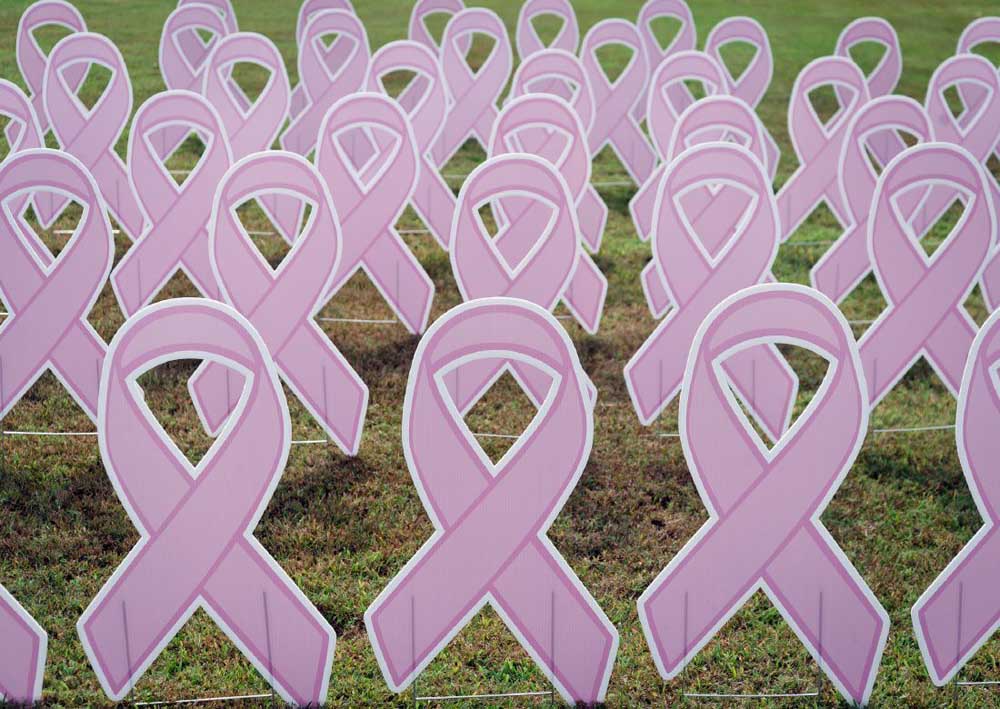What to know about breast cancer: Types, aftercare and East Texas support groups
Published 10:00 pm Sunday, October 6, 2024

- Seventy-six pink ribbons, each representing 100 patients who have had annual mammograms, fill the lawn in October 2017 in front of Christus Good Shepherd Medical Center. (Les Hassell/Longview News-Journal File Photo)
One in eight, or 13%, of women in the United States will develop breast cancer. The five-year survival rate for breast cancer caught at the localized stage is 99% according to the National Breast Cancer Foundation, Inc.
“Breast cancer is the most common type of cancer for women in Northeast Texas and the second most common cause of cancer deaths among women,” according to the Health Status of Northeast Texas 2021 Report.
Trending
In 2018, the mortality rate for breast cancer in Northeast Texas was similar to U.S. and Texas rates. Mortality rates for Black women were higher than any other group, according to the Health Status of Northeast Texas 2021 Report.
Types of breast cancer
Carcinoma breast cancer is the most common type of breast cancer. Carcinomas are tumors that start in the epithelial cells that line organs and tissues in the body. When carcinomas form in the breast, they are called adenocarcinoma — which start in the ducts or the glands that form milk, according to the American Cancer Society.
Other types of breast cancers can refer to where the cancer has spread. In situ breast cancer or ductal carcinoma in situ or DCIS refers to a pre-cancer that starts in the milk ducts but has not spread to the rest of the breast tissue, according to the ACS.
Invasive or infiltrating breast cancer is when the cancer has spread to surrounding breast tissue. The most common types are: invasive ductal carcinoma or invasive lobular carcinoma. Invasive ductal carcinoma makes up 70 to 80% of all breast cancers, according to the ACS.
Some special types of breast cancers are more rare and develop differently. This includes triple-negative breast cancer and inflammatory breast cancer, according to the ACS.
Trending
Triple negative breast cancer is an aggressive cancer in which the cancer cells do not have estrogen or progesterone receptors and make none or few of a protein called HER2. It accounts for 15% of breast cancers, according to the American Cancer Society.
Inflammatory breast cancer is an aggressive cancer which occurs when cancer cells block lymph vessels in the skin causing the breast to appear inflamed. It is a rare cancer, occurring in 1% to 5% of all breast cancers, according to the American Cancer Society.
Breast cancer can grow in other cell parts. However, this is less common and may require different types of treatments. Less common breast cancer types include: Paget’s disease of the breast, angiosarcoma and phyllodes tumor, according to the American Cancer Society.
Paget’s disease of the breast starts in the breast ducts and spreads to the skin of the nipple and then the areola. They make up one to three percent of all breast cancers, according to the American Cancer Society.
Angiosarcoma starts in cells that line blood vessels or lymph vessels. They make up one percent of all breast cancers, according to the American Cancer Society.
Phyllodes tumors develop in the connective tissue of the breast. Most tumors are benign. However, some are malignant, meaning they are cancerous, according to the American Cancer Society.
Patient and survivor’s care
There are many ways to treat breast cancer, including through surgery and radiation which treat cancer in a specific part of the body (such as the breast).
Chemotherapy, hormone treatment, targeted therapy, and immunotherapy drugs can reach cancer cells almost anywhere in the body, according to the ACS.
It is common for doctors to prescribe more than one treatment for breast cancer. Treatment depends on the cancer’s stage and grade; proteins; age; health factors; and patient’s feelings about the treatment and its side effects. Each treatment plan is unique to the patient and can vary.
Most women will have surgery, such as lumpectomy or mastectomy, as well as possible breast reconstruction.
While there are methods to treat symptoms, these may not always be standard medical treatments, according to ACS, such as vitamins, herbs, special diets, and other things. You may want to know more about these kinds of treatments, but it’s crucial to have these conversations with your professional care team.
After beating breast cancer, it is recommended breast cancer survivors establish primary care in order to monitor their health and survivorship issues. In addition, eating a heart-healthy diet helps with boosting survivors’ health and strengthening their immune systems. Lastly, exercising has been proven to reduce the recurrence of breast cancer, according to HealthBeat from Northwestern Medicine.
Survivors will have follow-up doctors’ visits, yearly mammograms if applicable, and other checks such as blood tests.
Support groups
After undergoing treatment, survivors may face complex feelings. It can be helpful for survivors to join support groups.
For survivors in Smith County and Cherokee County, there is a private Facebook group for survivors called: Breast Cancer Warriors of Smith and Cherokee Counties. To join the group visit https://tinyurl.com/bcwarriorsetx .
In Longview, Christus Good Shepherd Breast Center has a monthly breast cancer support group. For anyone interested in joining the group, email NETX.GS.Pinkribbonjourney@christushealth.org or call 903-315-3866. The next meeting will be Oct. 15 from 5:30 to 6:30 p.m. at the Good Shepherd Breast Center Medical Plaza, 705 E. Marshall Ave. Suite 1003 in Longview. The group meets the third Tuesday of every month.





